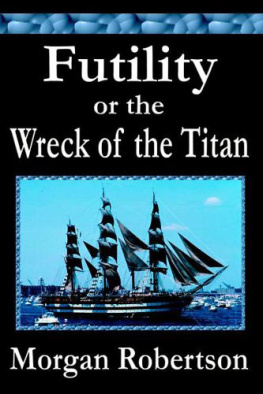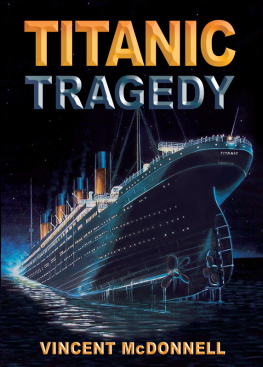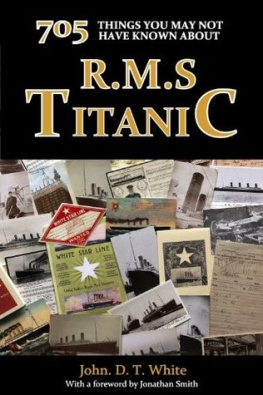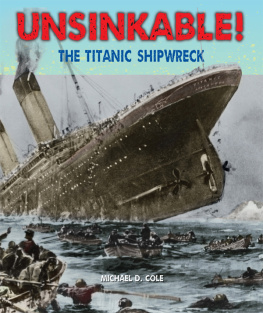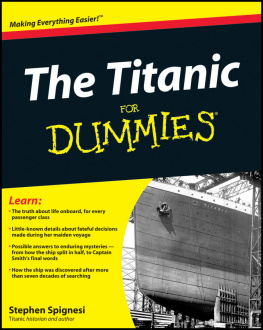The Wreck of the Titan
Or Futility
SHE was the largest craft afloat and the greatest of the works of men. In her construction and maintenance were involved every science, profession, and trade known to civilization. On her bridge were officers, who, besides being the pick of the Royal Navy, had passed rigid examinations in all studies that pertained to the winds, tides, currents, and geography of the sea; they were not only seamen, but scientists. The same professional standard applied to the personnel of the engine-room, and the stewards department was equal to that of a first-class hotel.
Two brass bands, two orchestras, and a theatrical company entertained the passengers during waking hours; a corps of physicians attended to the temporal, and a corps of chaplains to the spiritual, welfare of all on board, while a well-drilled fire-company soothed the fears of nervous ones and added to the general entertainment by daily practice with their apparatus.
From her lofty bridge ran hidden telegraph lines to the bow, stern engine-room, crows-nest on the foremast, and to all parts of the ship where work was done, each wire terminating in a marked dial with a movable indicator, containing in its scope every order and answer required in handling the massive hulk, either at the dock or at seawhich eliminated, to a great extent, the hoarse, nerve-racking shouts of officers and sailors.
From the bridge, engine-room, and a dozen places on her deck the ninety-two doors of nineteen water-tight compartments could be closed in half a minute by turning a lever. These doors would also close automatically in the presence of water. With nine compartments flooded the ship would still float, and so no known accident of the sea could possibly fill this many, the steamship Titan was considered practically unsinkable.
Built of steel throughout, and for passenger traffic only, she carried no combustible cargo to threaten her destruction by fire; and the immunity from the demand for cargo space had enabled her designers to discard the flat, kettle-bottom of cargo boats and give her the sharp dead-riseor slant from the keelof a steam yacht, and this improved her behavior in a seaway. She was eight hundred feet long, of seventy thousand tons displacement, seventy-five thousand horse-power, and on her trial trip had steamed at a rate of twenty-five knots an hour over the bottom, in the face of unconsidered winds, tides, and currents. In short, she was a floating citycontaining within her steel walls all that tends to minimize the dangers and discomforts of the Atlantic voyageall that makes life enjoyable.
Unsinkableindestructible, she carried as few boats as would satisfy the laws. These, twenty-four in number, were securely covered and lashed down to their chocks on the upper deck, and if launched would hold five hundred people. She carried no useless, cumbersome life-rafts; butbecause the law required iteach of the three thousand berths in the passengers, officers, and crews quarters contained a cork jacket, while about twenty circular life-buoys were strewn along the rails.
In view of her absolute superiority to other craft, a rule of navigation thoroughly believed in by some captains, but not yet openly followed, was announced by the steamship company to apply to the Titan: She would steam at full speed in fog, storm, and sunshine, and on the Northern Lane Route, winter and summer, for the following good and substantial reasons: First, that if another craft should strike her, the force of the impact would be distributed over a larger area if the Titan had full headway, and the brunt of the damage would be borne by the other. Second, that if the Titan was the aggressor she would certainly destroy the other craft, even at half-speed, and perhaps damage her own bows; while at full speed, she would cut her in two with no more damage to herself than a paintbrush could remedy. In either case, as the lesser of two evils, it was best that the smaller hull should suffer. A third reason was that, at full speed, she could be more easily steered out of danger, and a fourth, that in case of an end-on collision with an icebergthe only thing afloat that she could not conquerher bows would be crushed in but a few feet further at full than at half speed, and at the most three compartments would be floodedwhich would not matter with six more to spare.
So, it was confidently expected that when her engines had limbered themselves, the steamship Titan would land her passengers three thousand miles away with the promptitude and regularity of a railway train. She had beaten all records on her maiden voyage, but, up to the third return trip, had not lowered the time between Sandy Hook and Daunts Rock to the five-day limit; and it was unofficially rumored among the two thousand passengers who had embarked at New York that an effort would now be made to do so.
EIGHT tugs dragged the great mass to midstream and pointed her nose down the river; then the pilot on the bridge spoke a word or two; the first officer blew a short blast on the whistle and turned a lever; the tugs gathered in their lines and drew off; down in the bowels of the ship three small engines were started, opening the throttles of three large ones; three propellers began to revolve; and the mammoth, with a vibratory tremble running through her great frame, moved slowly to sea.
East of Sandy Hook the pilot was dropped and the real voyage begun. Fifty feet below her deck, in an inferno of noise, and heat, and light, and shadow, coal-passers wheeled the picked fuel from the bunkers to the fire-hold, where half-naked stokers, with faces like those of tortured fiends, tossed it into the eighty white-hot mouths of the furnaces. In the engine-room, oilers passed to and fro, in and out of the plunging, twisting, glistening steel, with oil-cans and waste, overseen by the watchful staff on duty, who listened with strained bearing for a false note in the confused jumble of sounda clicking of steel out of tune, which would indicate a loosened key or nut. On deck, sailors set the triangular sails on the two masts, to add their propulsion to the momentum of the record-breaker, and the passengers dispersed themselves as suited their several tastes. Some were seated in steamer cbairs, well wrappedfor, though it was April, the salt air was chillysome paced the deck, acquiring their sea legs; others listened to the orchestra in the music-room, or read or wrote in the library, and a few took to their berthsseasick from the slight heave of the ship on the ground-swell.
The decks were cleared, watches set at noon, and then began the never-ending cleaning-up at which steamship sailors put in so much of their time. Headed by a six-foot boatswain, a gang came aft on the starboard side, with, paint-buckets and brushes, and distributed themselves along the rail.
Davits an stanchions, mennever mind the rail, said the boatswain. Ladies, better move your chairs back a little. Rowland, climb down out o thatyoull be overboard. Take a ventilatorno, youll spill paintput your bucket away an get some sandpaper from the yeoman. Work inboard till you get it out o you.
The sailor addresseda slight-built man of about thirty, black-bearded and bronzed to the semblance of healthy vigor, but watery-eyed and unsteady of movementcame down from the rail and shambled forward with his bucket. As he reached the group of ladies to whom the boatswain had spoken, his gaze rested on onea sunny-haired young woman with the blue of the sea in her eyeswho had arisen at his approach. He started, turned aside as if to avoid her, and raising his hand in an embarrassed half-salute, passed on. Out of the boatswains sight he leaned against the deck-house and panted, while he held his hand to his breast.


